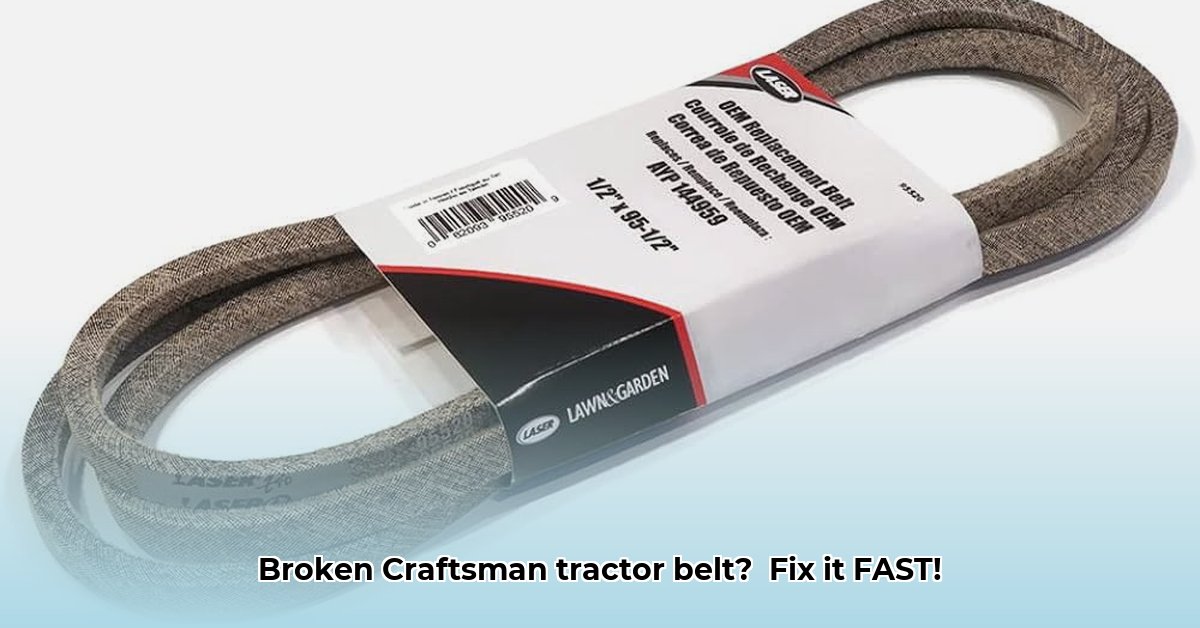
Keeping your Craftsman garden tractor running smoothly depends heavily on the condition of its belts. These essential components transfer power, ensuring efficient operation. This guide covers common problems, simple fixes, and maintenance tips to keep your tractor performing at its best. Are you ready to get your tractor back in top shape? For more information on garden tractor plows, check out this helpful resource: Garden Tractor Plows.
Identifying Your Craftsman Garden Tractor Belts: Finding the Perfect Fit
Before tackling any repair, you need the correct replacement belt. Your owner's manual is the ultimate resource, detailing belt size, type, and other specifications. If you can't locate your manual, the model number (usually found on a sticker under the seat or hood) is vital for online searches. A local hardware store or equipment shop can also assist in identifying the correct belt.
Troubleshooting Common Belt Problems
While inevitable, belt issues are often manageable. Here are some common problems and solutions:
Belt Slippage: The "Wheezing" Problem
A slipping belt, often accompanied by a wheezing sound, indicates wear or misalignment. Check belt tension; it should yield slightly when pressed. If too loose, adjust the tensioner pulley (refer to your owner's manual for instructions). Severe slippage usually necessitates replacement. Did you know that approximately 75% of belt slippage issues stem from improper tension?
Broken Belt: The "Uh-Oh" Moment
A broken belt demands immediate replacement. Before installing a new one, inspect pulleys for damage that might have caused the breakage. Replacing the belt without addressing pulley damage risks a repeat occurrence.
Squeaky Belts: The Annoying Noise
A squeaking belt often responds to lubrication. A belt dressing spray (follow instructions carefully) can be effective. Persistent squeaking, however, suggests wear or misalignment, requiring further investigation.
Step-by-Step Belt Replacement Guide
Replacing a Craftsman garden tractor belt is a manageable DIY task. Follow these steps:
- Safety First: Disconnect the spark plug to prevent accidental starts.
- Access the Belts: Remove any guards or covers obstructing access to pulleys.
- Remove the Old Belt: Carefully loosen belt tensioners and remove the old belt.
- Install the New Belt: Thread the new belt around the pulleys, following the path of the old belt (use your owner's manual as a guide).
- Adjust Tension: Tighten the tensioner to achieve proper tension. Incorrect tension, either too tight or too loose, can damage the belt.
Belt Maintenance: Extending Belt Lifespan
Regular maintenance significantly extends belt life. Before each use, inspect belts for cracks, fraying, or excessive wear. Clean belts and remove debris. Maintaining correct tension is crucial; an overly tight belt wears out faster.
Sourcing Replacement Belts: Where to Buy
Replacement belts are easily accessible from various sources:
- Online Retailers: Amazon, eBay, and similar platforms offer a wide selection, allowing for price comparisons.
- Local Hardware Stores: Many stores carry garden equipment and parts, providing convenient access.
- Specialized Tractor Parts Suppliers: These suppliers specialize in tractor parts, ensuring compatibility.
Belt Material Selection: Rubber, Polyurethane, or Kevlar?
Craftsman tractor belts are made from different materials, each with unique properties:
| Material | Advantages | Disadvantages |
|---|---|---|
| Rubber | Cost-effective, flexible | Prone to cracking, shorter lifespan |
| Polyurethane | More durable, longer lifespan | More expensive than rubber |
| Aramid Fiber (Kevlar) | Extreme durability, high tensile strength | Most expensive, potentially less flexible |
By choosing quality belts and performing routine maintenance, you can keep your Craftsman garden tractor in optimal condition for years. Happy gardening!